A density-dependent factor that regulates the population size of organism is
- A. Disease
- B. Sudden flood
- C. Drought
- D. Fire outbreak
The most important hormone that induces the ripening of fruit is
- A. Ethylene
- B. Indole acetic acid
- C. Gibberallin
- D. Cytokinin
The response of plants to external stimuli in a non-directional manner is known as
- A. Tactic movement
- B. Phototropism
- C. Geotropism
- D. Nastic movement
An example of a caryopsis is
- A. Guava
- B. Maize grain
- C. Coconut
- D. Tomato
Homologous pairs of chromosome separate during
- A. Cytolysis
- B. Cleavage
- C. Mitosis
- D. Meiosis
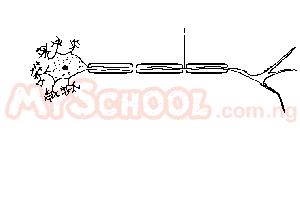
The point marked I is referred to as
- A. myelin sheath
- B. dendrites
- C. axon
- D. node of Ranvier
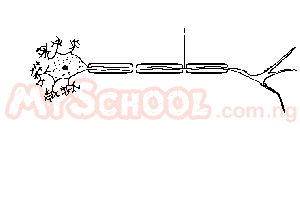
The structure can be found in the
- A. Sympathetic and parasympathetic nervous systems
- B. Peripheral and central nervous system
- C. Peripheral nervous system only
- D. Central nervous system only
Metabolic production of urea is carried out in the
- A. urinary bladder and kidney
- B. Liver
- C. Pancreas
- D. Kidney and malphigian tubule
In mammalian males, the excretory and reproductive systems share the
- A. Ureter
- B. vas deferens
- C. Urethra
- D. Testes
The best method of propagating sugarcane is by
- A. Seeding sowing
- B. Layering
- C. Grafting
- D. Stem cuttings
The part of the mammalian digestive system where absorption of nutrient takes place is the
- A. ileum
- B. colon
- C. oesophagus
- D. duodenum
Organisms I, II, III and IV have surface/volume ratios of 1:2, 1:3, 1:4 and 1:5 respectively. The organism that is likely to have the most complex transport system is
- A. IV
- B. III
- C. I
- D. II
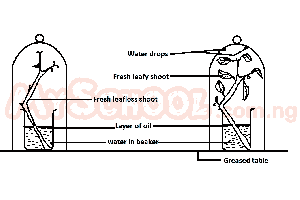
In the experiment, the layer of oil serves to prevent water loss
- A. transpiration
- B. evaporation
- C. osmosis
- D. guttation
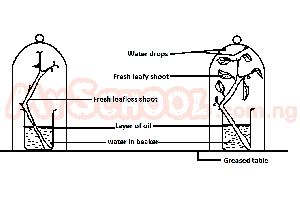
The experiment is used to demonstrate that
- A. plants lose water through guttation
- B. transpiration occurs through the leaves
- C. water is necessary for photosynthesis
- D. leaves are important to photosynthesis
The dark reaction of photosynthesis involves the
- A. reduction of carbon(IV)oxide to organic
- B. release of oxygen and the splitting of water
- C. photolysis of water and the production of starch
- D. splitting of water into hydrogen
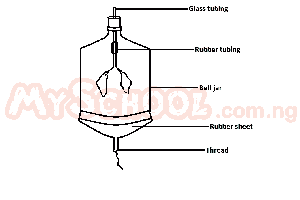
In the experimental set-up, the rubber sheet represents the organ called
- A. pleural cavity
- B. lungs
- C. diaphragm
- D. intercostal muscles

The aim of the experiment is to demonstrate
- A. that in mammal gaseous exchange takes place in the lungs
- B. the part played by the pleural cavity and diaphragm in respiration
- C. that a large amount of oxygen is absorbed by the lungs
- D. the presence of carbon (IV) oxide in the exhaled air
If water that has been coloured red is poured at the base of a wilting plant, it will appear as a red stain in the cells of the
- A. xylem
- B. epidermis
- C. phloem
- D. parenchyma
The stunted growth of a leguminous plant suffering from nitrogen deficiency may be corrected by inoculating the soil with
- A. denitrifying bacteria
- B. Saprophytic bacteria
- C. Rhizobium
- D. Nitrosomonas
The cell component that is present in a prokaryotic cell is the
- A. Chloroplast
- B. Ribosome
- C. Mitochondrion
- D. Nuclear envelope
An insect whose economic importance is both harmful and beneficial is the
- A. Tsetsefly
- B. Blackfly
- C. Mosquito
- D. Butterfly


